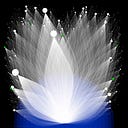Elusive Definitions: Lessons from “Computer Art” for “Cryptoart”
In the 1980s, a graduate student named Richard Lucas embarked on an intriguing project: He wanted to define “computer art.” His method? A systematic interview process called the Delphi technique, which involved polling leading artists like Monique Nahas and Lillian Schwartz and Frieder Nake and others.
I first read about a neat master’s thesis in Grant Taylor’s great history of computer and digital art, When the Machine Made Art. As Taylor described, this thesis aimed to interview prominent computer artists to help refine, define and codify our sense of “computer art.” I found Taylor’s summary (published in 2014) so curious I decided to find the full document myself, approved as an MA thesis in 1986. It’s a modest PDF of about 90 pages and could be found on the Ohio State University thesis archives.
Lucas’ aim was ambitious — to find consensus amongst experts about the nature of this burgeoning practice. Is it a new art form? Does it depart from prior art traditions and if so along which dimensions? What emerged from his research was interesting and somewhat fraught. It is an illustration of the challenges to finding clear criteria that define complex, conceptual domains, and holds relevant for emerging art communities like the one I love and follow: cryptoart.
Delphi: Two Phases of Survey
The Delphi method, in essence, involves two phases. The first draws out some discussion and opinions from respondents. The second phase gets a follow-up response from respondents after preparing a summary of the first phase for further reflection. Researchers, in this case Lucas, then synthesize the comments in an attempt to find common ground.
Initially, in phase one, there was resistance to categorizing computer art as a distinct genre. Traditional aesthetic principles, to many respondents, seemed adequate to encapsulate the emerging techniques involving computers.
Lucas summarized the phase one outcome as mainly (though not entirely) highlighting traditional aesthetic principles. He created neat response tables to juxtapose perspectives in a broader view.
In phase two of his methodology, Lucas highlighted some dimensions that seemed like potential sources of innovation in computer art, such as enhanced interactivity with art and a fundamentally changed conception of digital dissemination.
Despite further discussion, no clear consensus was reached. Two distinct perspectives seemed to crystallize, at least on my read. One group saw computer art as an extension of existing artistic expression, expanding upon established aesthetic frameworks. Another group, a smaller but vocal contingent, questioned imposing fixed criteria on such a fluid and rapidly evolving medium. Lillian Schwartz illustrated this point by referencing Fantin-LaTour’s work, once vaulted away in New York’s Metropolitan Museum of Art but later featured and celebrated. She was highlighting how artistic valuation can shift dramatically over time.
This thesis research offers important insights for those attempting to define “cryptoart” today. Just as with computer art decades ago, the landscape is filled with diverse voices and evolving perspectives. Imposing rigid definitions or ranking projects based on fleeting trends may introduce more problems and distractions for those who are learning to make it and appreciate it. At least, that’s one interpretation of this exercise.
In Taylor’s history, published in 2014, he highlights how postmodernism eventually showed up to offer theory that frames computer art in ways that may help to highlight its unique disruptive semiotic potential. Writers like Timothy Binkley argued that computer art belonged in a postmodern framing, a framing that is characteristic of resisting simple dimensional and categorization schemes. This seems compelling, and indeed consistent with the second “cluster” of responses that emerged from Lucas’ research. Just as importantly though so much of Taylor’s history of computer art reflects on the desperate search for validation, legitimacy, critical appreciation and so on that computer art simply seemed incapable of garnering for so many years. The term itself came under attack in prominent treatments:
Conclusion: Defining Cryptoart
In any case, like the artists Lucas interviewed, we could embrace a more fluid approach, recognizing that cryptoart’s identity is still being shaped. As Schwartz reminded us, artistic understanding is not static; it ebbs and flows, constantly adapting to new ideas and technologies. Instead of seeking definitive overcommitals, the best course of action may be to remain open, curious, and ready to engage with the ongoing conversation surrounding our own new and evolving “metamedium.”
I still very much favor a set of loose criteria shared by “Artnome,” Jason Bailey, in an early article about cryptoart. There are intriguing features that characterize the space. But like the research from Lucas, we would remain cautious to take them as fundamentally distinct or definitive. They are, nevertheless, a prompt to think about an expanding space of expression that seems to wend its way into all pockets of human experience and technology.
I’m on X and Farcaster and also make creative projects in the cryptoart space. I welcome a follow, and also shared a thread on this post here.
I have a related post you may take interest in, presenting my recent project “Collective Filter” as a kind of cryptoart performance:
